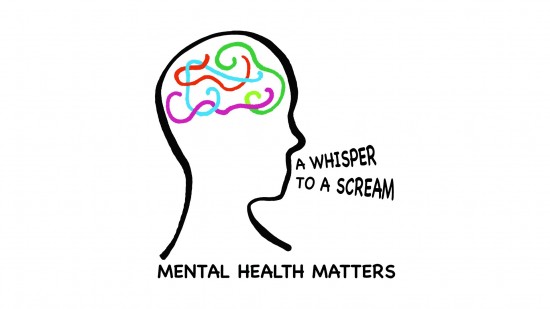If you had the opportunity to stop Adam Lanza from shooting 27 innocent people at Sandy Hook Elementary School, or to speak to Robin Williams before he took his own life, or to convince fifteen-year-old Fredrick Lochridge to not murder his ten-year-old sister, would you even know where to begin?
Mental illness is a terrible disease whose reputation is more harmful to those impacted than the illness itself. The lack of education and conversation about mental health is primarily at fault for the drastic consequences of said illnesses. According to a survey conducted by the American Association of Pediatrics, over 75% of pediatricians agree that comprehensive mental health programs should be a crucial component of our schools.

An aerial shot of Sandy Hook Elementary School, December 12, 2012, the same day Adam Lanza killed 27 people, comprised mostly of 6 and 7-year-olds.
The fact of the matter is that each year, one in four adults experiences some sort of mental illness, otherwise known as mental disorders, and one in seventeen adults endures a serious mental illness such as bipolar disorder, major depression, or schizophrenia—these figures spell out 61.5 million people directly affected in America alone (National Alliance on Mental Illness, 2013). When looking at the mental health statistics in regards to our youth, the numbers are just as shocking. According to the National Alliance on Mental Illness (2013) approximately 20% of today’s youth ages thirteen to eighteen and 13% ages 8-15 live with some form of mental illness each year.
Neglecting these mental health issues can only hurt those inflicted and the greater community by contributing to the high suicide rates, increasing danger of mass shootings, and broadening the gap between otherwise like-minded people. By integrating mental health education as a mandatory part of our schools, we will make the appropriate resources available to our developing youth who may be seeing, but not recognizing, signs of mental illness in themselves, friends, or family.
It is crucial that we take a stand internationally to make mental health education a required attribute of our primary and secondary schooling systems; doing so will erase the stigma against mental illness, encourage people to start talking about the issue, and minimize the amount of innocent lives we lose each year to suicide, homicide, and mass shootings.
A Brief History
Mental illness can be traced back as far as 6500 BC, as derived from prehistoric cave art. Different cultures for thousands of years have been shown to believe that mental illnesses such as hysteria and depression were due to supernatural causes, but it was Hippocrates who first suggested that mental illness was a consequence of natural circumstances. Asylums were introduced in the early sixteenth century as institutions to confine the mental ill and criminal. People were held in horrendous conditions against their will, having all basics rights taken away from beneath them due to the title “mentally ill”.

An illustration of a Milwuakee County Insane Asylum dated back to the mid 1800s. Many of these asylums were known for their horrendous conditions and treatment of patients.
The eighteenth and nineteenth centuries focused on humanizing these asylums, but mental health wasn’t truly properly approached until the early half of the twentieth century when psychoanalysis became the dominant psychogenic treatment for mental illness. It was only then that behavioral, cognitive, cognitive-behavioral, psychodynamic, and client-centered approaches to psychotherapy were put into place (Porter, 2002).
Due to the awful misconception of mental illness throughout history, as exemplified by the terrible conditions considered acceptable for these poor people years ago, many people still have stigma against mental illness. Most commonly, nonbelievers will either believe the person is choosing to act in a certain way, or that he or she was born with a screw loose and there’s just no fixing it. In both cases, they are of course very wrong.
Recent History
Neglecting mental health in our society can very seriously negatively impact the events that occur on a day to day basis. “Suicide is the tenth leading cause of death in the U.S. (more common than homicide) and the third leading cause of death for ages 15 to 24 years”; statistics show that 90% of people who commit suicide had some sort of underlying mental illness (National Alliance on Mental Illness, 2013).
Separately, mass shootings have become increasingly more common in the past decade, and most of the perpetrators also have been shown to have underlying mental health issues. With this large of a portion of our population taking their own lives and the lives of others each year as a consequence of these mental disorders, it is crucial that we start attacking this issue where it begins.

An info-graphic putting the mental health statistics into an even easier to digest format. To take a closer look, check out the National Alliance on Mental Illness website.
According to the National Alliance on Mental Illness (2013), one-half of all chronic mental illness begins by the age of fourteen; three-quarters by age twenty-four. These numbers make it evident that in order to successfully prevent disasters such as suicide, homocide, and mass killings from occurring in the future, we must start educating people on mental health and illnesses when they are young and in an environment where the subject matter is taken seriously. This school environment, where there is so much opportunity to prevent these awful circumstances, is also one of the most vulnerable environments to these types of attacks. Homocide, and mass shootings in particular, have been increasing in numbers in the past decade and a half.
According to the FBI in 2014, ten years ago, from 2000 to 2006, there was an average of 6.4 active shootings per year. From the year 2007 to 2013, there was an average of 16.4 such shootings. It is important to mention that these figures do not specify mass shootings, but rather active shooter incidents, defined by the FBI as a “situation in which a shooting is in progress and an aspect of the crime may affect the protools used in responding to and reacting at the scene of the incident”. According to the same study, approximately 45% of the shootings occurred in public locations such as offices and stores, 25% occurred at schools and universities, and the remaining percentage took place in private homes, government office buildings, military bases, etcetera.
FBI analysts note that it seems many of these deadly rampages are in fact planned, having evidence that many of the gunmen studied high-profile shootings before conducting his own. The fact that these gunmen are glamorizing their actions is horrifying. The frightening aspect of the matter is that 73% of these shooters are under the age of 39; the median age of gun murderers is 26 years old.
Considering that the brain isn’t considered fully developed until the age of 25, it is very important to evaluate the malleability of many of these young, plausibly already struggling minds. These brash acts of homocide and mass murder are becoming an appealing way for misunderstood kids and young adults to get out their frustrations and to get the attention they feel they finally deserve.
The basis for this misunderstood feeling?—the underlying stigma against mental illness. Without educating ourselves and each other on mental disorders, we will become less accepting of others and consequently drive them to the lonely, insecure place that inspires these actions.
Strides Forward
In 2013 a National Alliance on Mental Illness study revealed that almost 50% of youth in-between eight and fifteen-years-old with a mental illness were not provided any mental health services through school or any private healthcare provider. These are figures that we are desperately trying to reduce. In recent years, the dollar amount that states have put into mental health care has fluctuated.
For example, between 2009 and 2012, due to the recession, states cut $4.35 billion from mental health service funds. This action left many people suffering from mental illness within these states with absolutely no access to mental health services. Fortunately, both 2013 and 2014 were years of minor mental health fund increases, but no increase has yet to make up for the cuts made back in 2009.
This is not to say we are worse off than we were a decade ago, however, for in 2014, legislation was passed in particular states to “improve the transparency of health insurance information”, better coordinate procedures between inpatient and outpatient mental health care, and “increase the mental health workforce, school-based mental health services, and early intervention for youth with mental health needs” (NAMI, 2014).

Senator Chris Murphy

Senator Bill Cassidy
In terms of national strides, last year the S. 1945: Mental Health Reform Act of 2015 was introduced by Senator Chris Murphy and Senator Bill Cassidy. In an evaluation on the reform conducted by Mental Health Care America, we can see that the bill has not touched on each of the crucial actions we need to implement in order to fully revise US health care, but it does emphasize several important areas of change. S. 1945’s emphasis on community-based systems of care, enhancing the behavioral health workforce, developing new evidence-based programs, and screening & early intervention is a great basis for the mental health reform, but it fails to specifically mention integrating mental health in schools, or where the funds will come from.
One major concern is that instead of taking money out of jails and prisons to put toward mental health, that the money will come out of other health services’ funds. Mental health should be considered an important entity in itself, and therefore should not have to take any funds from other crucial health service providers.

Nyhavn canal in Copenhagen, Denmark, a country that sets a phenomenal example of making mental health education and care readily available to every citizen.
When comparing the United States’ health care system to Denmark’s, otherwise known as the happiest country in the world, we can notice blatant similarities when it comes to the mental illness statistics, and even more blatant differences with how these mental health issues are dealt with. Although it is granted the title of the happiest country in the world, Denmark is no stranger to mental health disorders. In fact, on the basis of Denmark’s own health care register’s data, it is estimated that approximately 38% of women and 32% of men in Denmark will receive treatment for some sort of mental illness at some point in his or her lifetime. Including cases that weren’t serious enough to require treatment would bring the figures near half of the Danish population.
These numbers are not drastically different from the same statistics for the United States; what is drastically different, however, are the homicide and mass murder rates. The suicide rate in the US is higher than in Denmark, and the intentional homicide rate in the United States is 7 times that of Denmark.
These numbers are very likely due to Denmark’s universal health care system which includes mental health treatment. Although it is not necessary for the United States to follow Denmark’s health care and mental health care system completely, Denmark does present itself as an example of successful implementation of mental health care.
The Naysayers
Most people can agree, due to the surplus of statistics available representing the negative outcomes of mental illness, that integrating mental health education programs into our schools is a wise, or rather crucial, use of resources. Nevertheless, mental illness skeptics will likely argue that mental disorders are all in the head and therefore will be an inappropriate use of tax dollars, teacher’s efforts, and student’s time.

Although I grant that the integration of these mental health education programs will indeed create a new sector in which schools will put funds, effort, and time, I still maintain that mental disorders are in fact “real” illnesses, and that it is essential for mental health education to be a fundamental part of schools internationally.
Individuals who do not believe that mental illnesses are in fact “illnesses”, but rather a figment of one’s imagination, tend to lack an understanding of the significant tie in-between an education on mental health and the deaths of innocent individuals. These people tend to base their argument off of mental health education being an inappropriate use of our tax dollars. I refute this, however, with one simple thought—people in your personal life are more affected by mental illness than you are aware. In America alone, serious mental illnesses creates approximately $193.2 billion in lost earnings each year (National Alliance on Mental Illness, 2013). Instead of inflicting these costs on individual families, mental health should be a national investment.
By each citizen recognizing the gravity of mental health issues and the possible dangers of neglecting these illnesses, we can each contribute a minuscule amount to devote to the mental health crisis. The dollar amount is a small fee to pay for the sanity, happiness, and life of any community.
Conclusion

The fact of the matter is, mental illness is taking millions of innocent lives, but it is a problem that is completely preventable. The stigma that we have built internationally against mental illness has driven those affected to feel helpless and take drastic measures to deal with the pain, such as suicide, homicide, and even mass murder.
The lack of education and conversation about mental health among those not directly affected is a huge factor in why these events occur in the first place; raising awareness is the first step in preventing any more of these tragedies from occurring.
The fact of the matter is, if Adam Lanza had been diagnosed with schizophrenia before the Sandy Hook Shootings, it is very likely that there would be 20 more fifth graders learning the past presidents in Newtown, Connecticut. The fact of the matter is, if Robin Williams had been less ashamed to open up about his Lewy Body Dementia, perhaps he wouldn’t have fallen into a depression and taken his own life. The fact of the matter is, if anyone had taken note of Fredrick Lochridge’s behavioral issues prior to his murdering of his younger sister, it is likely he wouldn’t have been allowed to play with guns.
Mental illness is not the sole contributor to these violent crimes and tragedies, but it is an incredibly prevalent and preventable factor that must be addressed internationally.
The United States, as a leader in rates for many of these type circumstances (homicides and mass shootings), especially should take a stand and bring mental health to the forefront of our efforts. According to a survey conducted by the American Association of Pediatrics, more than 3/4 of pediatricians agree that comprehensive mental health programs should be a required component of our schools.
It is necessary for us to take a stand internationally and make mental health education a required attribute of our primary and secondary schooling systems; doing so will erase the stigma against mental illness, encourage people to start talking about the issue, and minimize the amount of innocent lives we lose each year to suicide and other mental illness induced tragedies.
Understanding mental illness is the first step to curing it. The ancient latin saying scientia potentia est means knowledge is power, but in this case, scientia vita est— knowledge is life.





